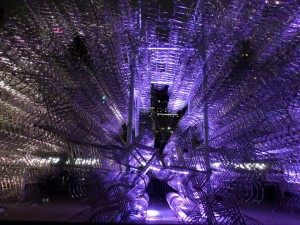MARIE PARK
<Layout Editor>

As night fell upon the streets of Toronto on October 5, 2013, hundreds of thousands congregated to experience Nuit Blanche. Though many were artists in their own right, many were also members the general public with a topical understanding and awareness of modern art. Many such individuals may know of Pablo Picasso and Henri Matisse, but may shake their head when asked about another character of the modern era who is too often less credited.
For those with a working knowledge of art history, Marcel Duchamp is a revered name, but for those who know and understand art on a more-or-less superficial level, Duchamp is an elusive character, and the significance of his works is too often misunderstood and understated. As aspiring artists and art appreciators, one must know how this one artist influenced a lasting and profound change of the role of art to the artist, and in turn, to the audience as well.
Duchamp is perchance most known for his piece entitled Bicycle Wheel – literally, a bicycle wheel mounted and inverted onto a stool. It caused some outrage in the artistic community of his time, as such a simple object in such a simple presentation could not possibly have been considered an honest piece of art. But as the years progressed, this piece, as well as his subsequent other “readymade” sculptures, became acknowledged for teaching artists an invaluable lesson about their own identities and their work as artists.
A most crucial lesson hidden in these seemingly everyday, mundane objects was this: art is more than an object of technical creation; it is a vehicle that can capture the infinite potential of human expression through forms that can be felt through the physical senses. It is a method of transforming abstractions, or thoughts, into tangibles so that other individuals can experience them, in their own perceptions, through the interaction of a physical manifestation of those thoughts. What this means is that an artwork is not merely a visual ornament; it is an attempt of the artist to transmit the conscious thoughts and experiences that exist in their minds through media that can be seen, felt, heard, touched, or otherwise sensed.
An artist is one who can identify the abstract, an idea, and present it in a form that can be subjectively interpreted by an audience. In contemporary and modern art, this experience of transmittance and reception of the idea is the artwork itself. Without understanding this, contemporary art can appear nonsensical and sometimes mindless.
Duchamp understood this in an age where the artistic community just began to abandon notions of art simply as decoration. Artists began to revolt against the ideals of traditional art, where excellence in art arose from the artist’s ability to replicate historical forms of perfection. Art began to leave the realm of purely decorative to become art for art’s sake. Duchamp contributed to this movement substantially when he presented the everyday objects as art; it was in his intent to make these objects into art that in fact made them into artworks. Without the artist’s intent, there is no art. A bicycle wheel is simply a bicycle wheel. As such, Duchamp’s Bicycle Wheel is a brilliant testament to the creativity of mankind.
Nearly all works in this year’s Nuit Blanche has a semblance to the infamous Bicycle Wheel. In fact, the bicycle wheel itself is used as a motif for many of the main pieces. Ai Weiwei’s Forever Bicycles utilizes the bicycle wheel in a three-dimensional pattern of geometric repetition. Each of the 3,144 bicycles have wheels that rotate on its axle, and throughout the night, thousands walked through the installation to spin a few of these wheels. It was a powerful symbol of a rapidly changing social environment, completed by the interaction provided by the audience.
Another piece is Ferris Wheel, by Katharine Harvey of Markham, Ontario. The sculpture has an obvious link to the bicycle wheel. The bright lights illuminate the round metal frame, continuously spinning to represent how the simple creation of art by simple means is in itself a form of celebration.
To write a comprehensive summary of all the pieces exhibited in the 2013 Toronto Nuit Blanche would be too extensive to demonstrate your correspondent’s message – but one final commentary summarizes all too perfectly the experience of the night.
From afar, the piece looks nothing more than a wooden-frame passageway covered by a translucent plastic sheet, an austere light illuminating it in a fluorescent haze. Close up, through the gaps in the plastic one could see walls of paper, folded accordion-like, lining both sides of the passage way on racks, floor to ceiling. A line-up of people congests the entryway, as the spectators enter one-by-one at the direction of the attendants. Each walks in with a sense of curiosity and bewilderment. Each leaves with astonishment as a paper crown is placed upon their brows; the folded origami pieces open up into a geometric pattern, and adorn the heads of those who entered.
The art in this piece, Paper Orbs, is in the cumulative human experience that is created by those who chose to participate – at the level of the artists in the initial inception of the idea, as participants whose personal experience is the art itself, and for those who see the exodus of white paper crowns and witness the dispersive behaviour of human masses akin to Brownian-motion.
Conceptualizing the art in this piece then leaves one to realize that the art in Nuit Blanche does not simply present itself in the pieces themselves, but in the phenomena of the gathering – how often does an idea move such masses of people in unison, against the irrationality of foregoing sleep in order to be an observer of the potential of the human mind?
